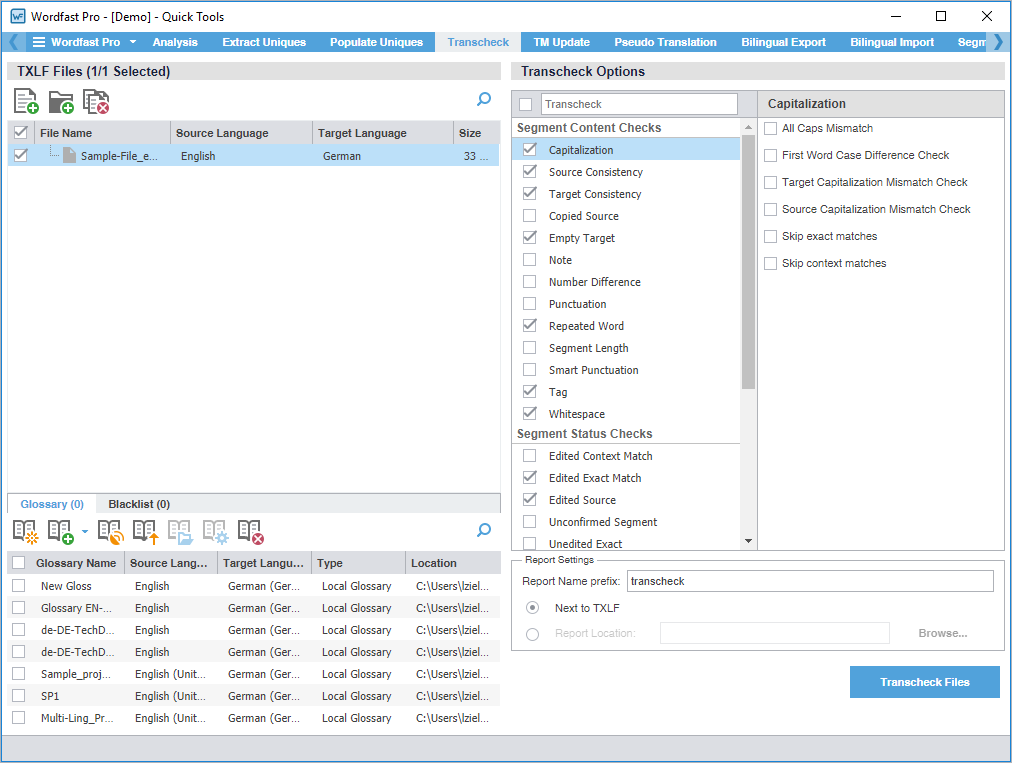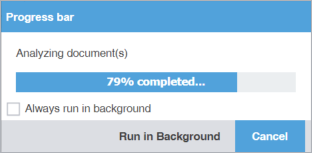You can use Transcheck to scan translated content for non-linguistic errors such as missing tags, empty targets, numbers, and terminology within target segments. Using the Quick Tools Transcheck action is best for running on groups of files as a bulk batch.
| Best Practice: If you have specific terms you want Transcheck to ignore, you can mark those segments for exclusion to reduce false positives during Transcheck error detection. |
To run Quick Tools Transcheck:
- Click the Wordfast Pro drop-down menu and select Quick Tools.
- Click the Transcheck tab, if it is not already selected.
- On the TXLF Files panel, choose one of the following actions:
- Select an action for the Glossary or Blacklist tabs.

Note: To search the Glossary Name or Blacklist Name column for a particular string, enter the search string in the available search field next to
 on the Glossary or Blacklist panels.
on the Glossary or Blacklist panels.Option
Action
Select to create a new glossary or blacklist and add it to the list of available ones.
Select and choose from the drop-down list to add to a local or project glossary or blacklist.
Select to connect a remote glossary or blacklist to the project.
Select to import .TBX or tab-delimited files to a glossary or blacklist assigned to the project.
Select to modify a glossary or blacklist assigned to the project.
Select to remove a glossary or blacklist assigned to the project.
- On the Transcheck Options panel, select items within any of the major categories.
- Select items for the Segment Content Checks category.
Option
Action
Select to identify any capitalization issues for translated segments in the edited file.
Select for consistency of source content across a single file or multiple edited files.
Select for consistency of target content across a single file or multiple edited files.
Select to identify any target segments that are identical to the source segment in the edited file.
Select to identify any empty target segments that do not contain a translation in the edited file.
Select to identify any target segments in the edited file with related notes.
Select to compare numerical values in source and target segments in the edited file, then identify any discrepancies.
Select to compare punctuation in source and target segments in the edited file, then identify any discrepancies.
Select to identify any repetitions of words in target segments within the edited file.
Select to compare source and target segment length in the edited file, then identify any discrepancies.
Select to confirm the punctuation in the target segment is correct for that language.
Select to identify any target segments in the edited file with missing tags.
Select to compare source and target segment white space usage in the edited file, then identify any discrepancies.
- Select items for the Segment Status Checks category.
Option
Action
Select to identify any changes to the context matches for translated segments in the edited file.
Select to identify any changes to exact matches for translated segments in the edited file.
Select to identify any updates to the original segment content in the edited file.
Select to identify any translated segments marked as unconfirmed in the edited file, so not committed to the translation memory.
Select to identify any unedited or overlooked exact match segments in the edited file.
Select to identify any unedited or overlooked fuzzy match segments in the edited file.
- Select items for the Reference Checks category.
Option
Action
Select to cross-reference the available blacklist with the edited file.
Select to identify any provided forbidden characters remaining within the edited file.
Select to identify any mistranslated or inaccurate translation in segments within the edited file.
Select to compare the length of source and target paragraphs in the edited file.
Select to identify any misspellings in translated segments within the edited file.
Select to identify any overlooked terminology matches for translated segments in the edited file.
Select to identify all target segments that contain content that cannot be translated in the edited file.
Select to identify all target segments that contain untranslated machine translation (MT) content in the edited file.
- Select items for the Segment Content Checks category.
- Create your Report Settings.
- Click Transcheck Files.
- (Optional) On the Progress bar dialog, you can select Always run in background to preserve the background batch action for future analysis actions, then click Run in Background.
- If you chose to run Transcheck in the background, you can monitor its progress.
- After successful completion, view the report, then close the report browser window.


